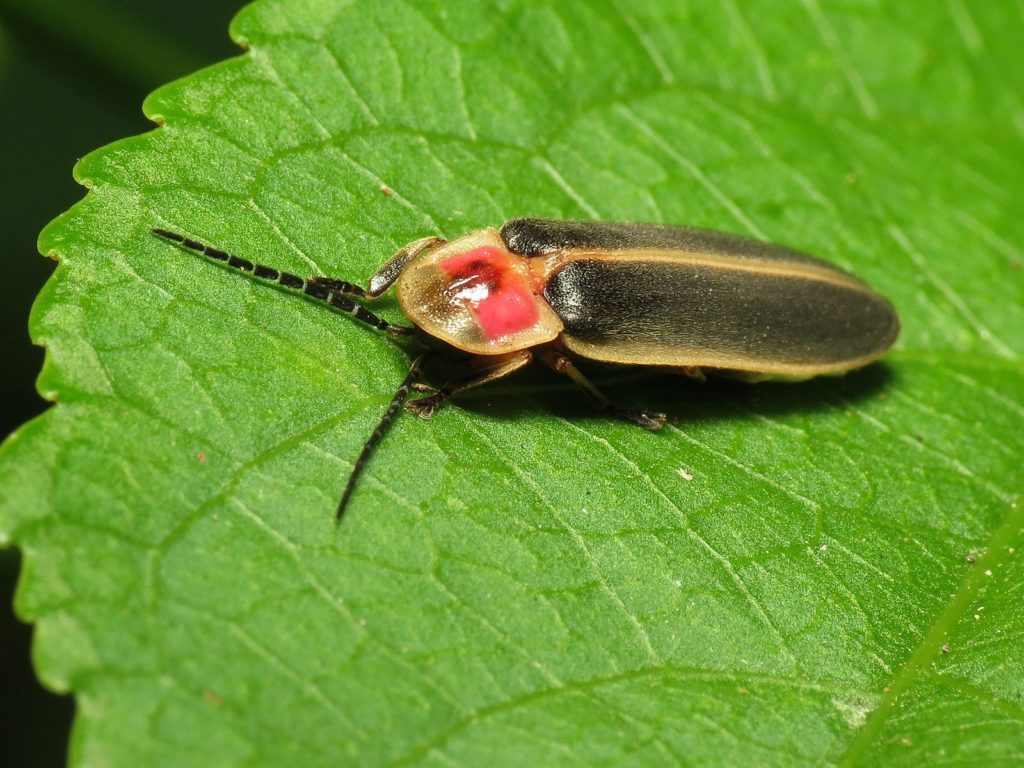Almanac: First Light

Common Eastern Firefly. Photo: Nature Rules 1 Wiki. Creative Commons
A friend and I were walking at night last week through the forests and fields north of UMass. The moon was up as we came into the wide, wild field below the Renaissance Center. Here and there amid the tall grass, we spotted some fireflies blinking their green/yellow semaphores—the first of the season. There were only a dozen or so, but these few were the vanguard of what will become a nightly spectacle as millions upon millions of these little insects put on nightly displays of sparkling, wonderous, bioluminescence.
Fireflies are not flies at all—they’re beetles, with leathery, striped wing covers and long, segmented antennae. They’re friendly little insects, slow moving, incapable of biting, and perfectly willing to be held and examined at close range. More than 2000 species of fireflies light up warm nights around the world, and there are many different species locally. Each species has a distinct flash intensity, duration, pattern, and sometimes even hue.
Fireflies in our northerly latitude spend between one and three years as larvae, feeding voraciously on all sorts of critters living in or on the ground. The bellies of the larvae glow, just like the abdomens of the mature fireflies, and you can see these “glow worms” along stream banks or other places where the ground isn’t covered with plants. I’ve seen glow worms on nighttime swims in the Fort River, for example, and while walking on roads with high dirt banks on either side. Glow worms don’t shine as brightly as fireflies and they don’t blink. They just, well…glow softly. The key to seeing them is to avoid flashlights—you need to let your eyes dark-adapt. Then they’re easy to spot.
After a period of time that varies from species to species, the larvae crawl to a safe spot and undergo a metamorphosis akin to that of a caterpillar transforming into a butterfly. Their bodies are literally taken apart and put back together again in a completely different structure, which is one of those little facts about nature that only becomes more mind-boggling the more you think about it.
Anyway, after about two weeks, the adults emerge with sex on their minds. The males wing about displaying flash patterns that differ between individuals in ways undetectable to humans. Females are more sedentary, but they will flash, in return, when they spot a male who’s pattern intrigues them. That these tiny-brained creatures have visual processing abilities so keen they can detect the subtlest differences in the flash patterns of potential mates is incredible. But detect and respond they do. After mating, the females lay eggs on the ground, and then both males and females die, their entire short adult lives spent in what must be a nearly psychedelic nightly experience of light.
The light itself is cold—no heat is involved in its production or emission. The light is generated chemically inside an organ called, appropriately enough, the “lantern.” The lantern contains a compound called luciferin (from Latin meaning “light-bearing”—it’s not an allusion to the devil), and an enzyme called luciferase. In a complex sequence of reactions that takes place in milliseconds, the large luciferase molecule wraps around the luciferin and holds it long enough for it to react with oxygen, magnesium, and other compounds. These reactions energize the luciferin molecule, sort of like charging a battery. When the luciferin relaxes back to its ground state, a photon of light is emitted. This light is usually yellow-green, but some fireflies emit blue light and others produce a redder light.

Turning oneself into a tiny flying neon sign doesn’t, on the face of it, seem like a wildly brilliant idea in a world full of hungry nocturnal predators such as bats. Turns out, though, that firefly blood contains a number of very nasty-tasting chemicals. Once a predator eats one, it won’t eat another. This is the same strategy used by monarch butterflies, which are just as flamboyant in their own way, and just as unpalatable. So not only are fireflies using light to attract mates, they’re using it, also, to signal to predators: “Don’t eat me…I taste just as awful as that other guy you ate.”
The fireflies we saw, and all the fireflies you’re likely to see around here, blink to the beat of their own drummer, producing a random scintillation. But some species in some locations will become synchronized, blinking as a unit. I’m not the only one who thinks this would be totally cool to see. Every year, in early June, thousands of people flock to Elkmont Tennesee, a ghost town, now located inside the Smoky Mountain National Park. Elmont’s claim to fame is that it’s the site of one of the largest known populations of synchronous fireflies. The displays are so popular that access is strictly controlled with a lottery system.
This is on my list of road trips to take when I retire and have time to indulge my curiosity about unusual flora, fauna, and geology. Until that fabled time arrives, I’m more than content to go out and enjoy the local bioluminescent pyrotechnics of summer.
Almanac is a regular Indy column of observations, musings, and occasional harangues related to the woods, waters, mountains, and skies of the Pioneer Valley. Please feel free to comment on posts and add your own experiences or observations.

1 thought on “Almanac: First Light”